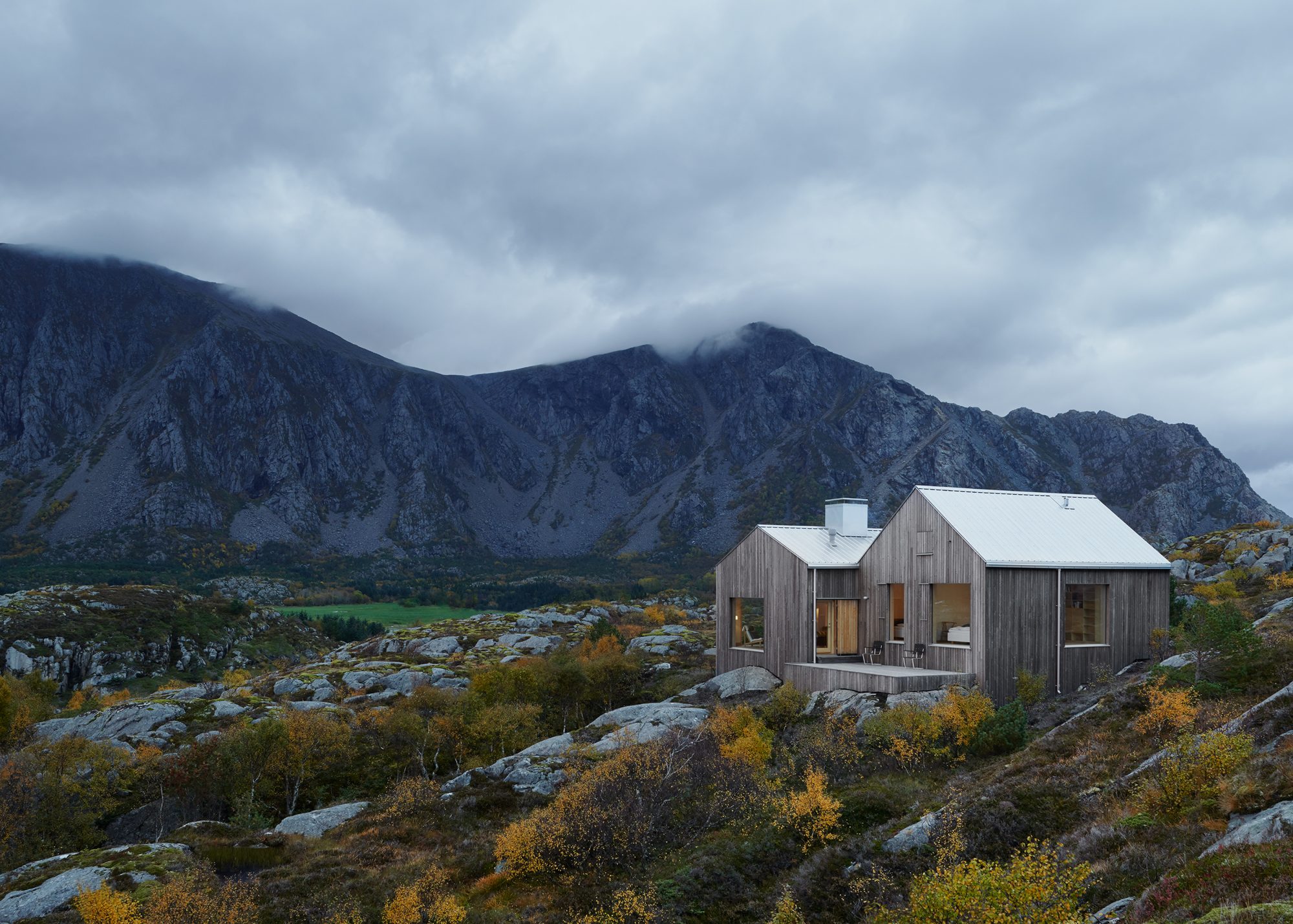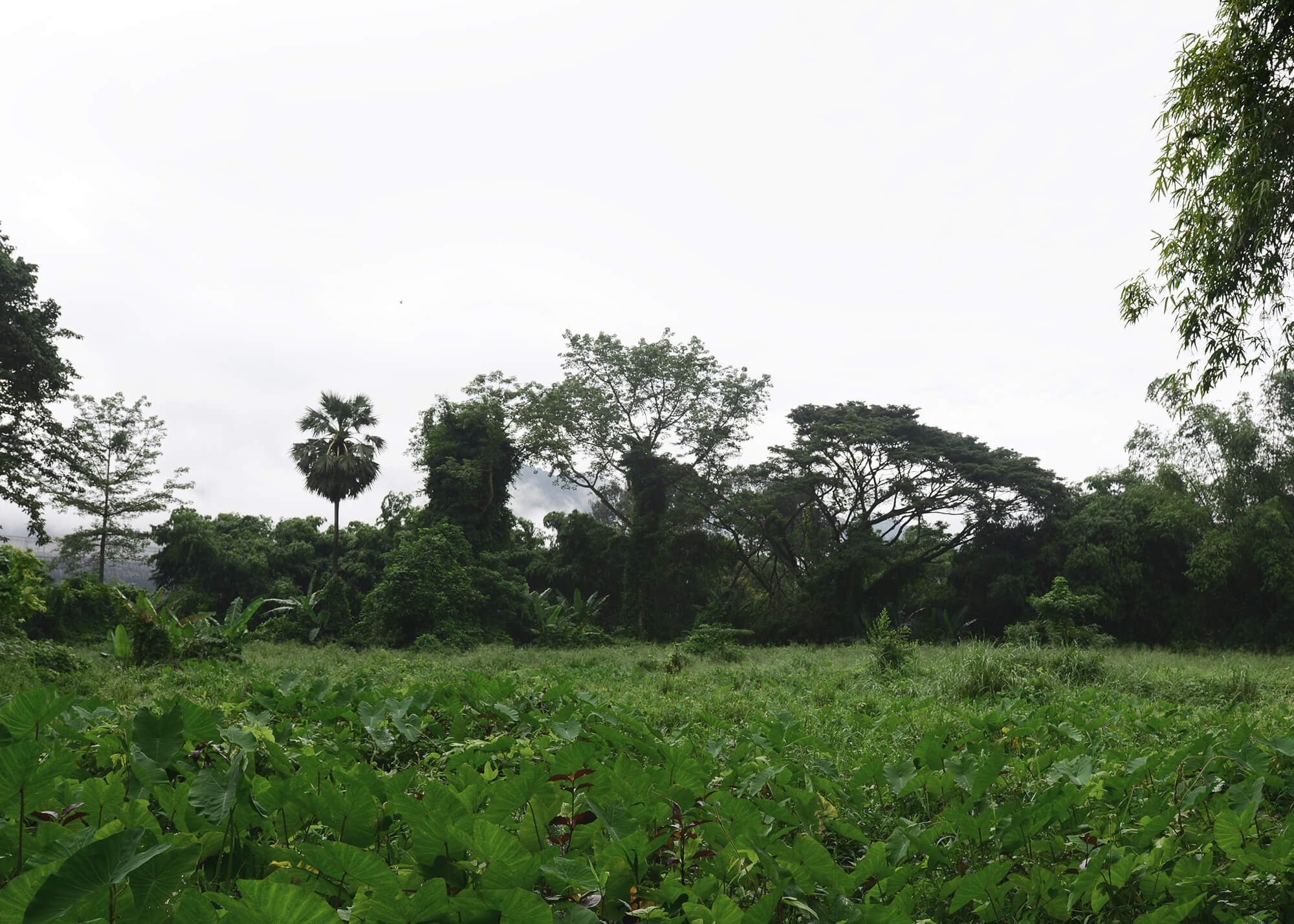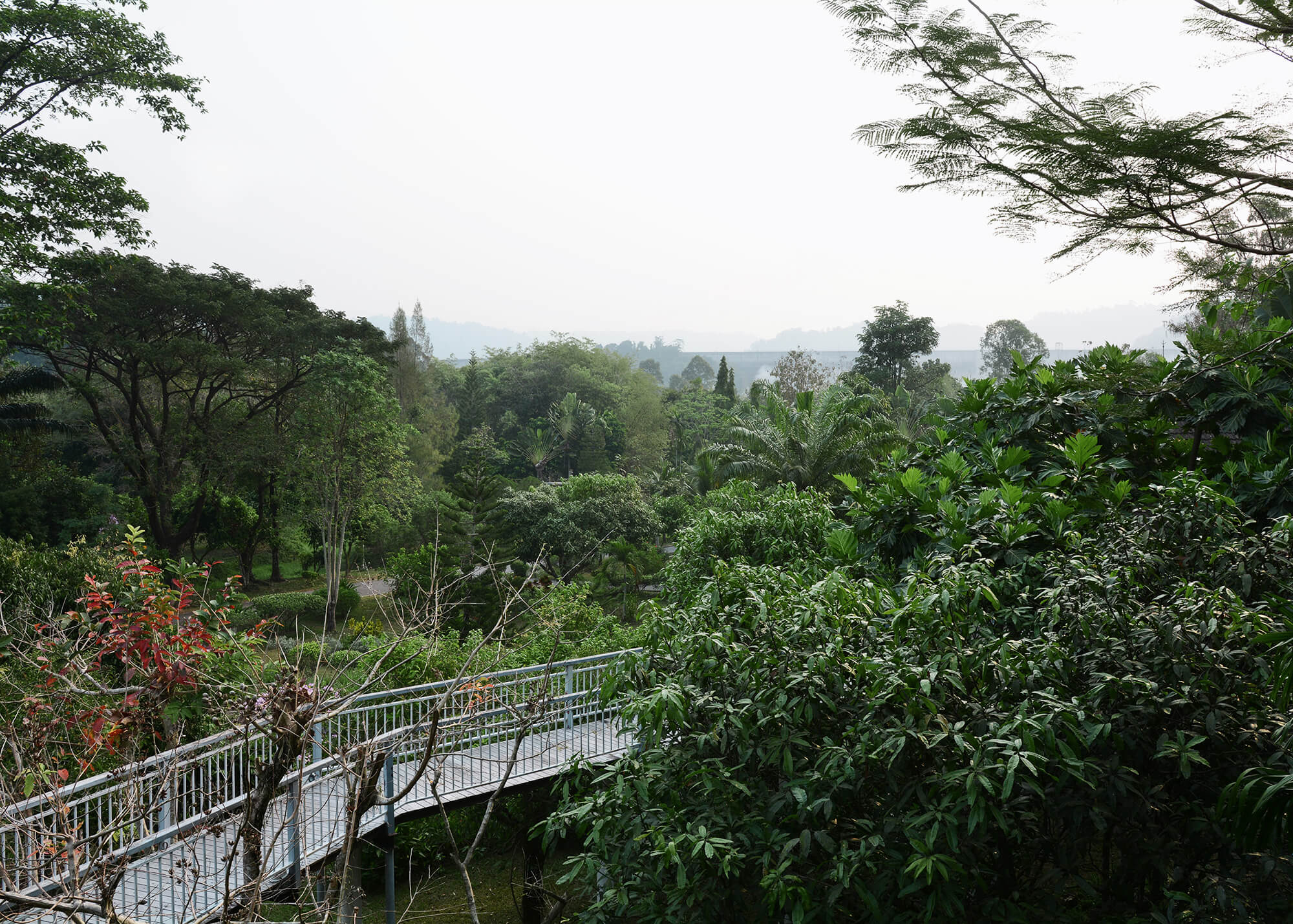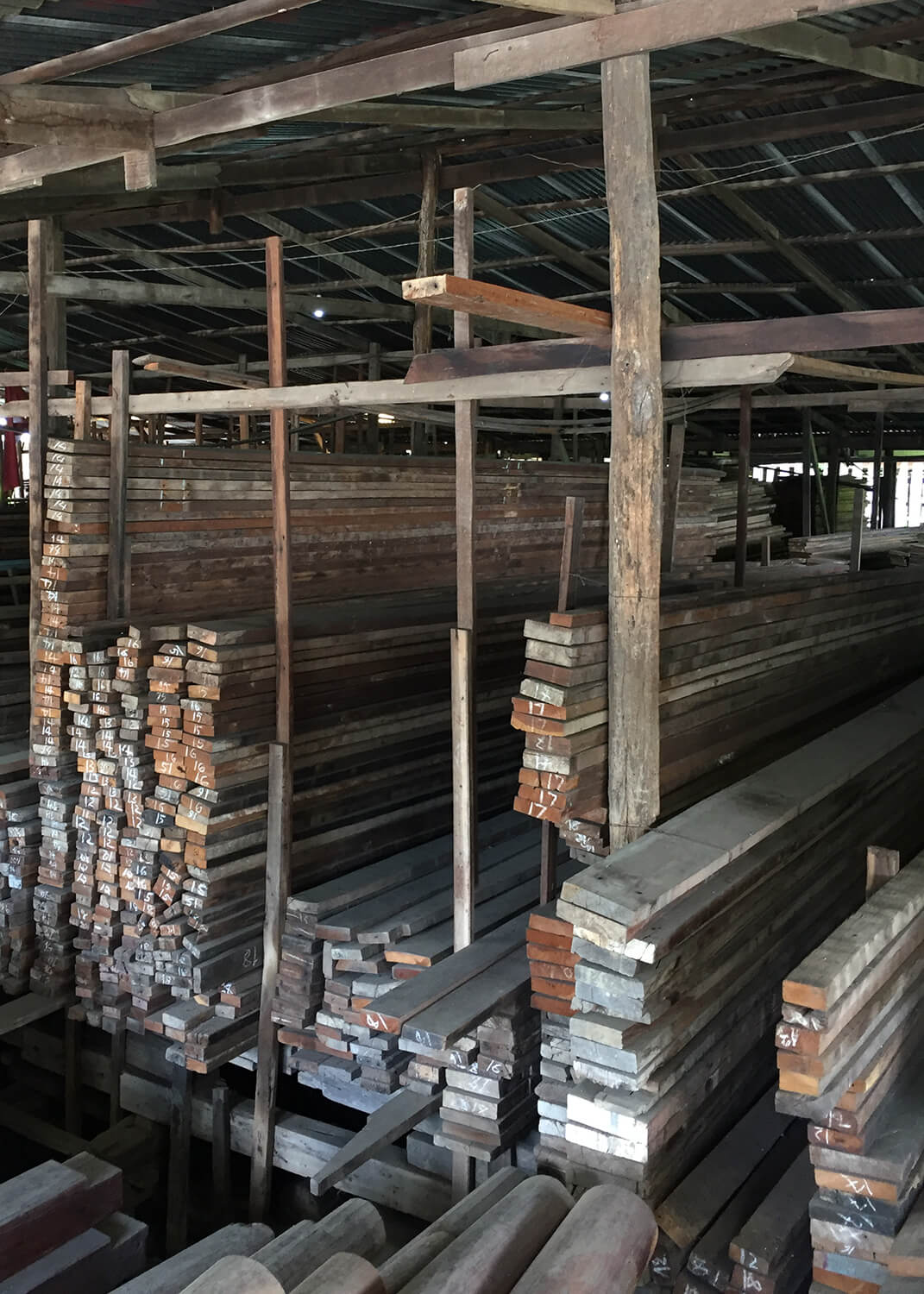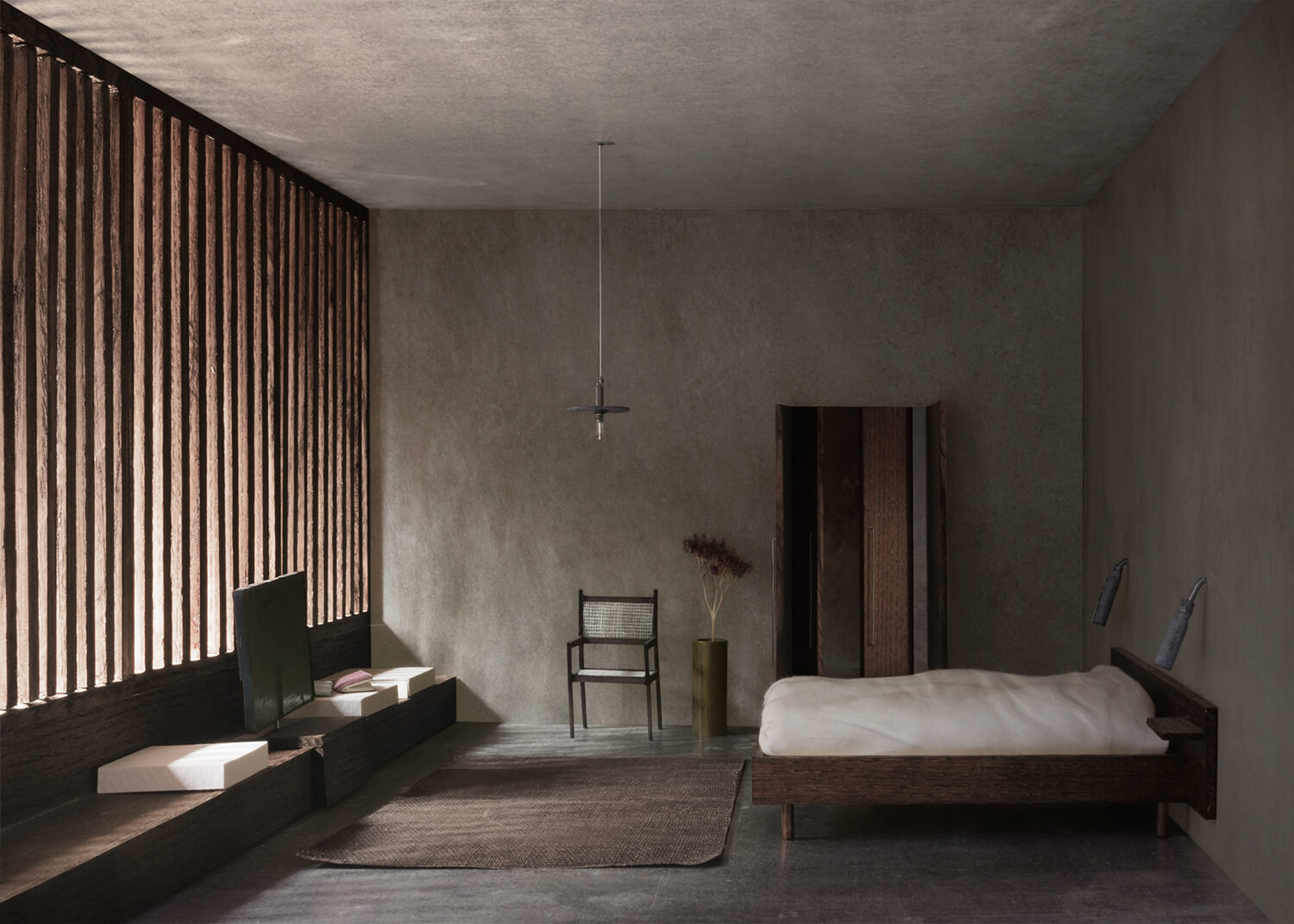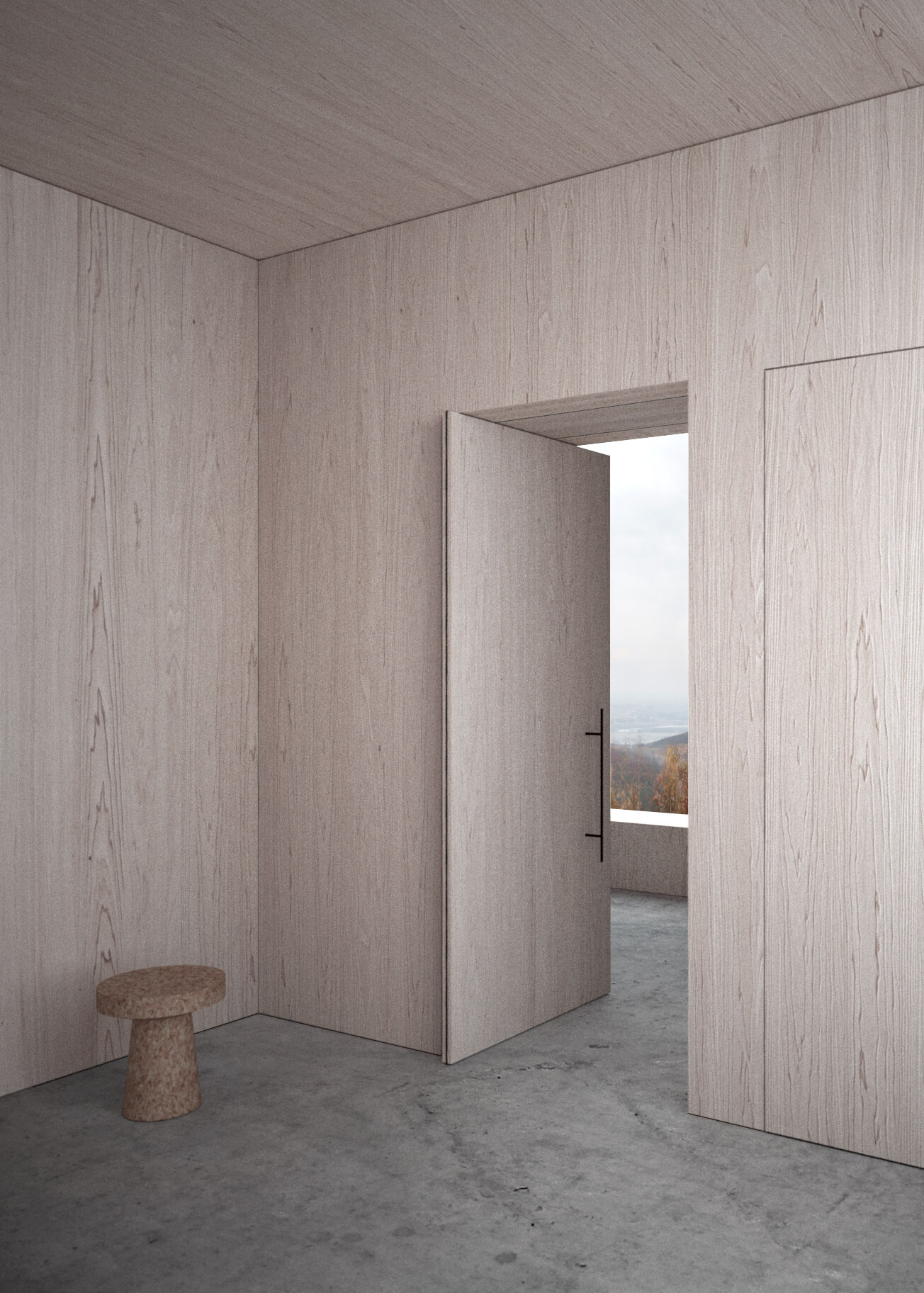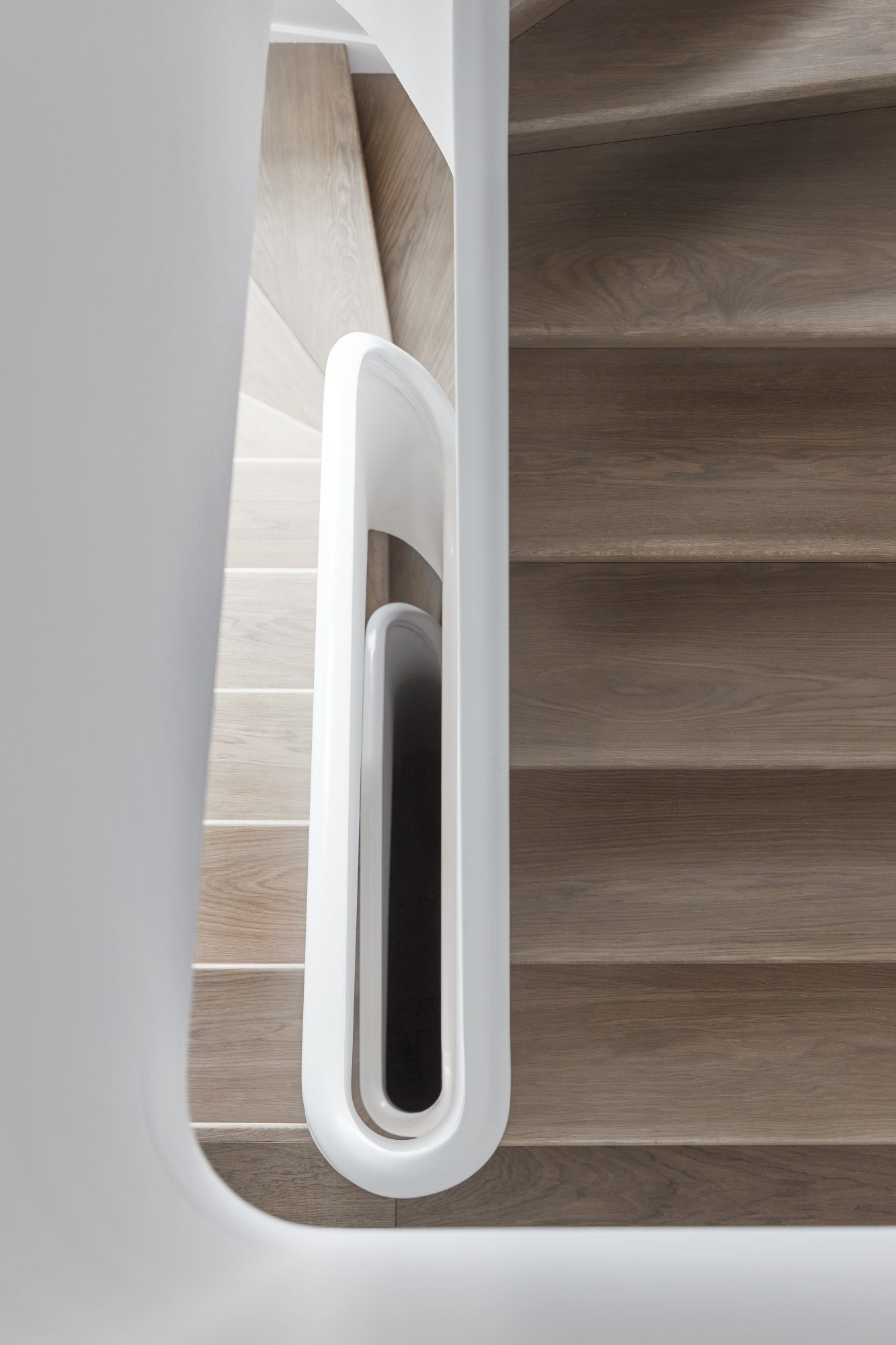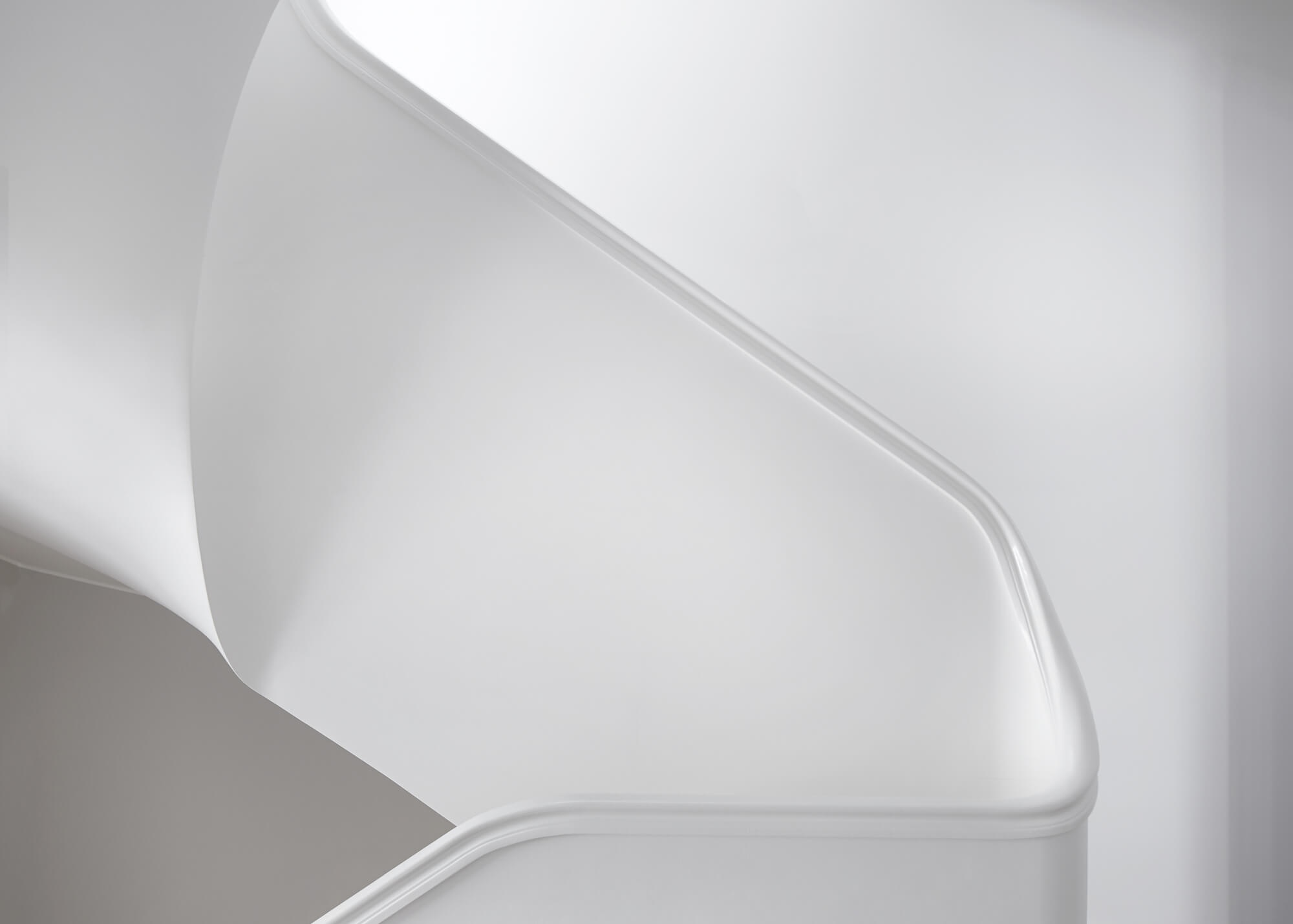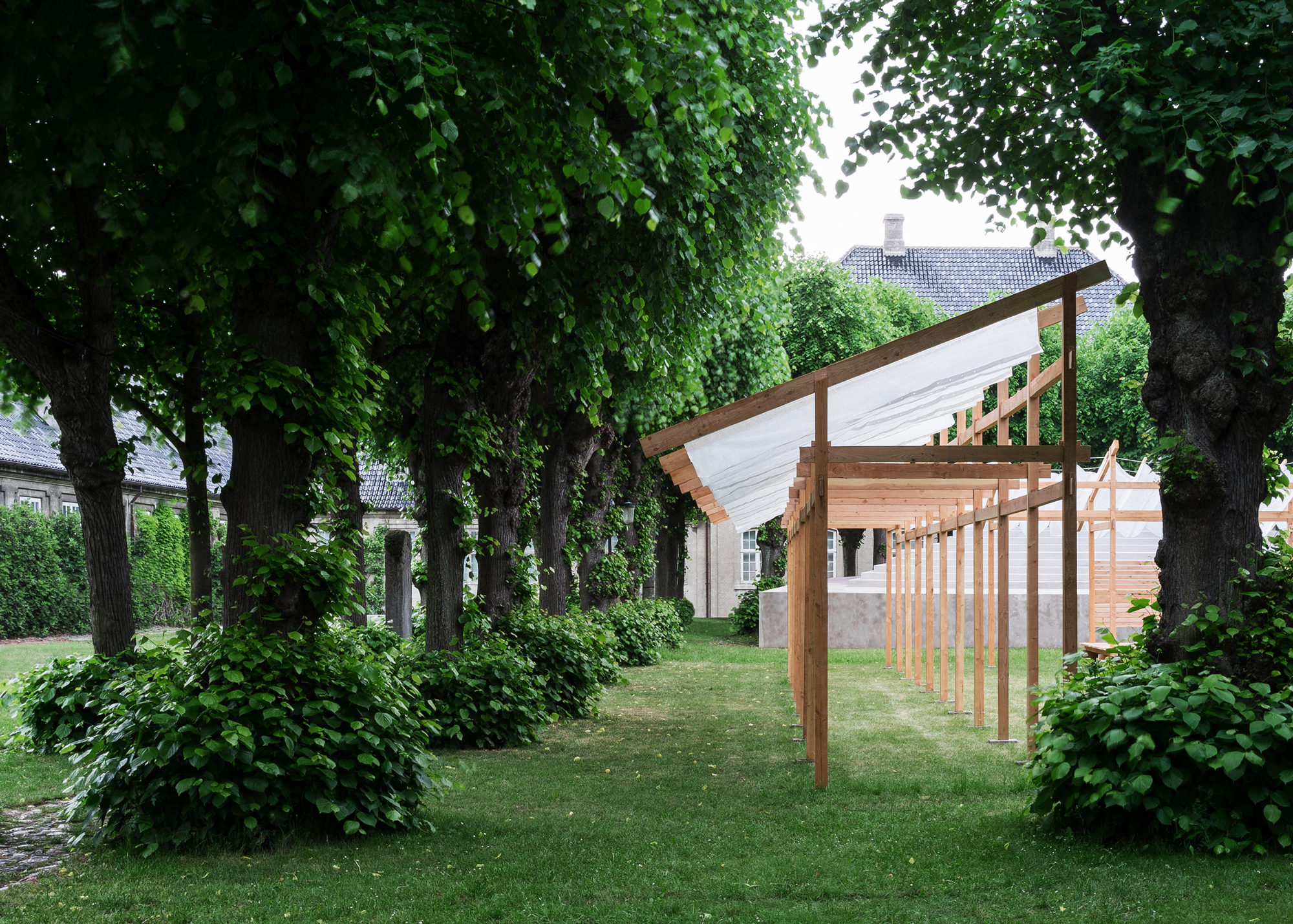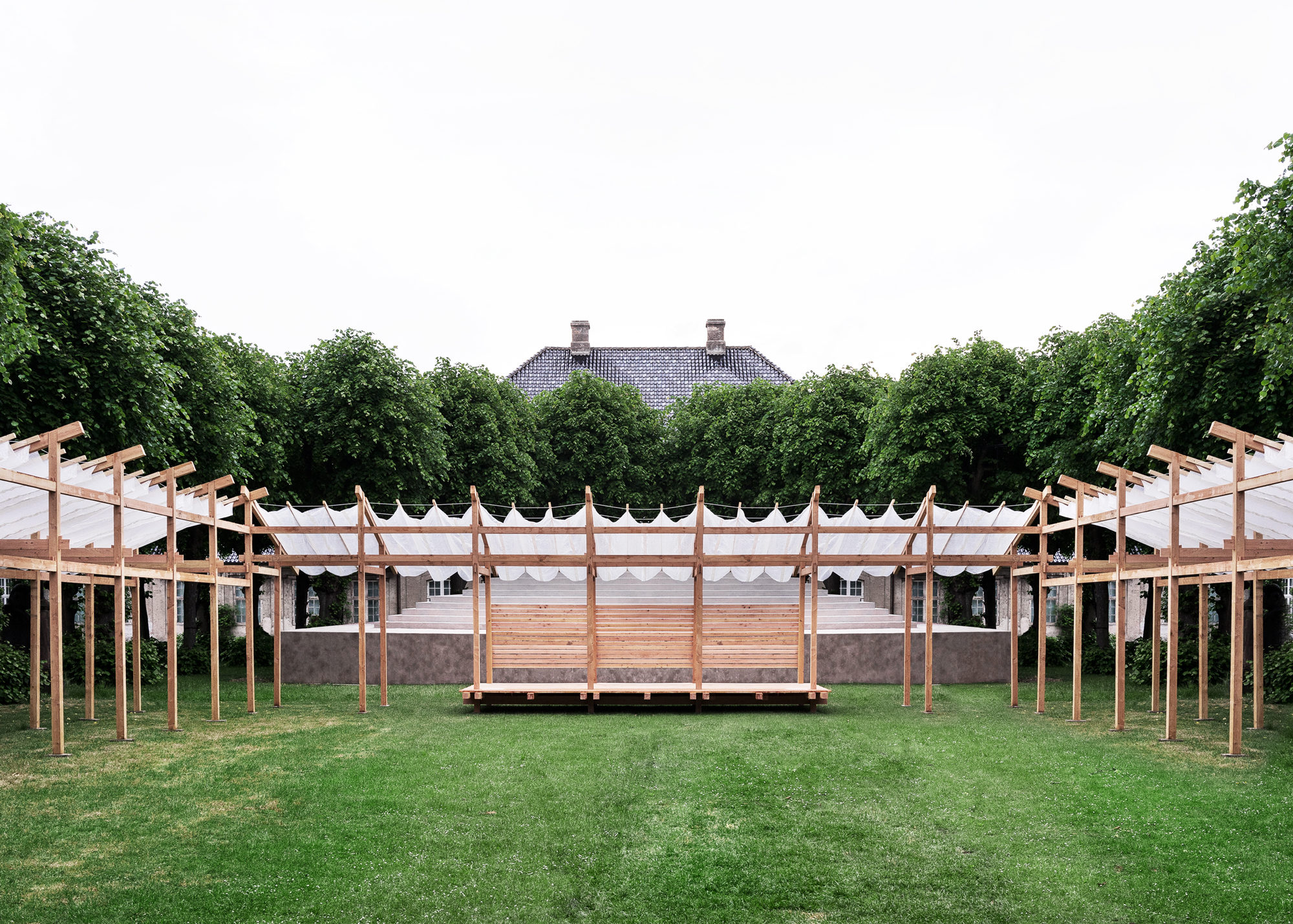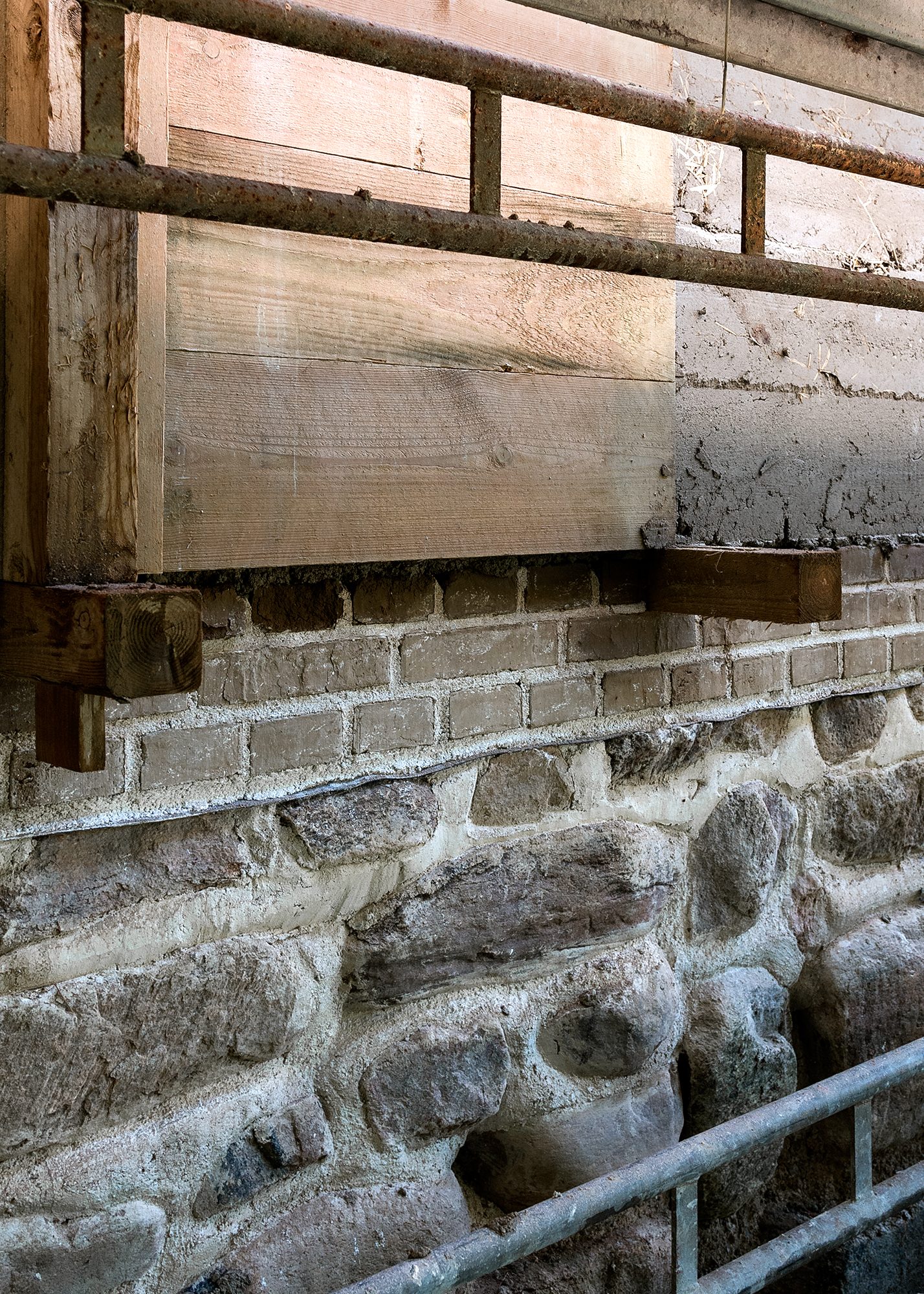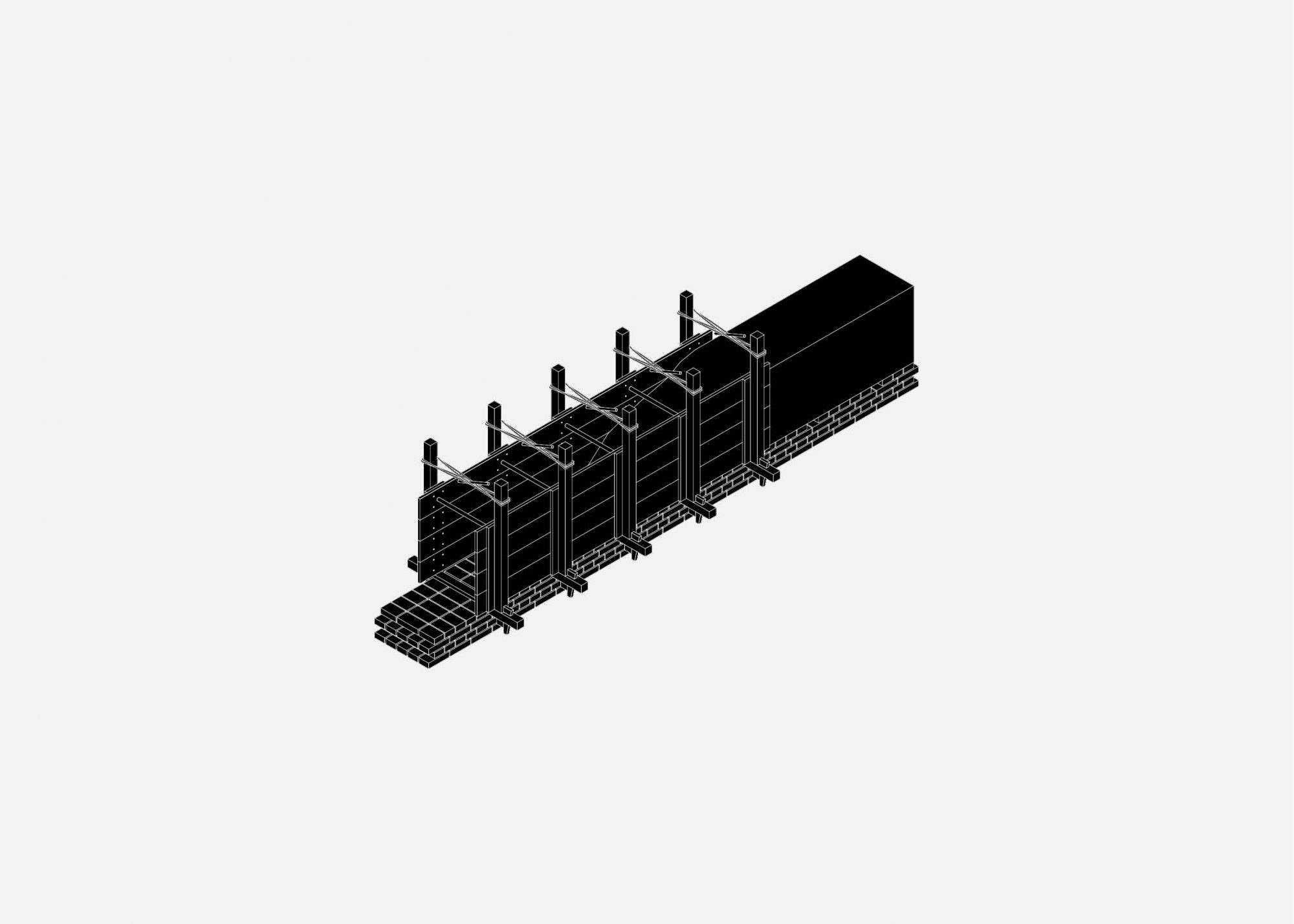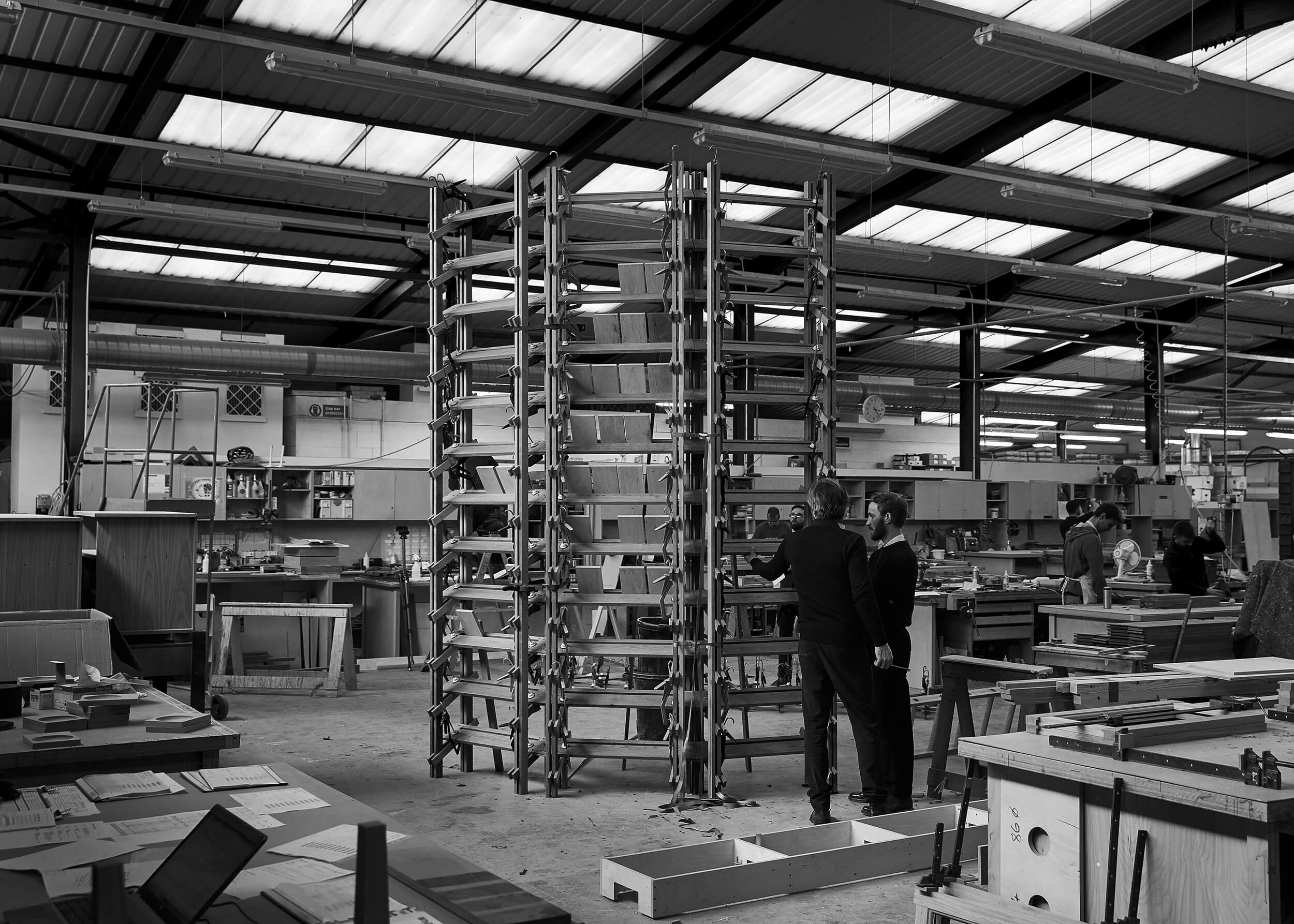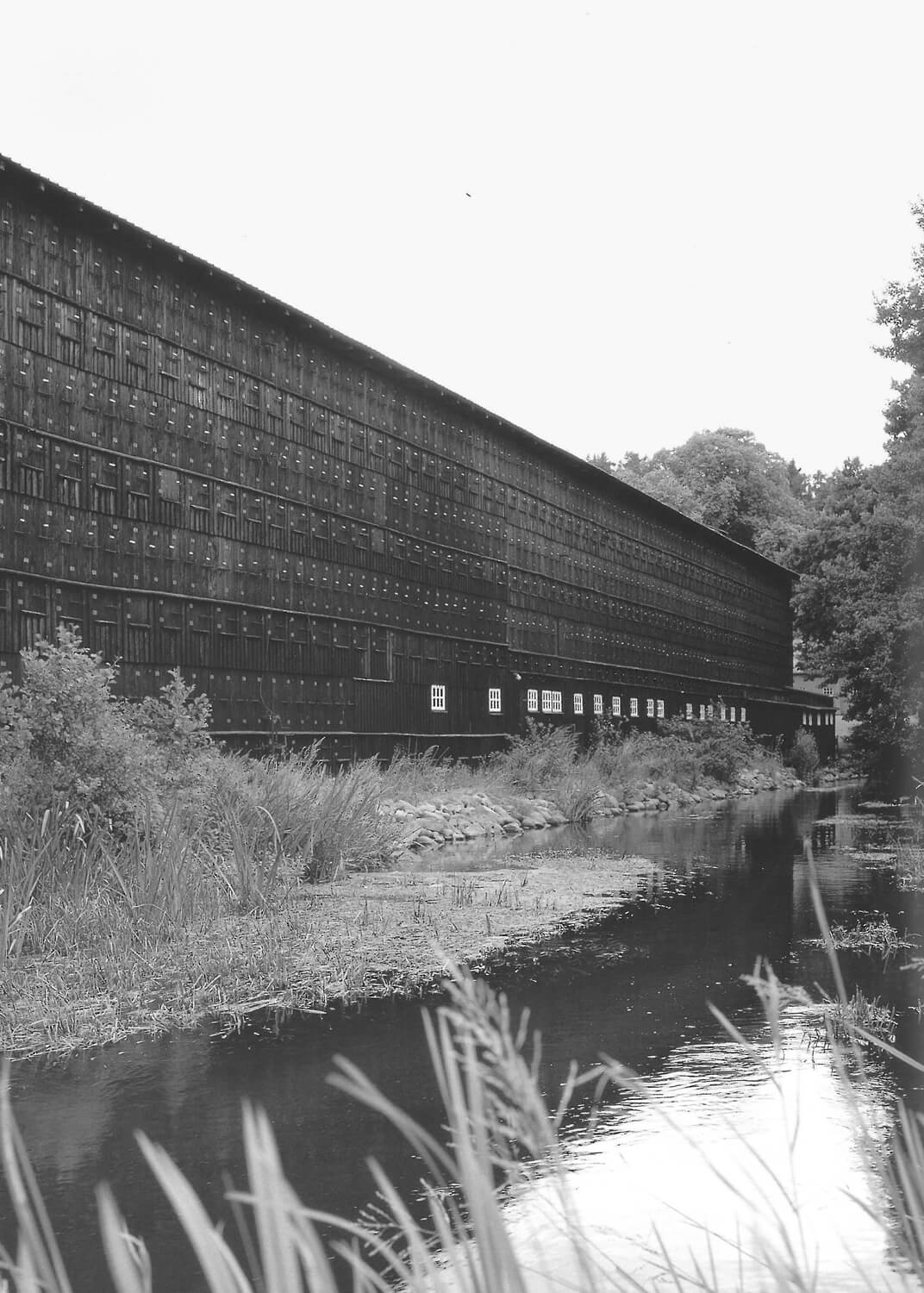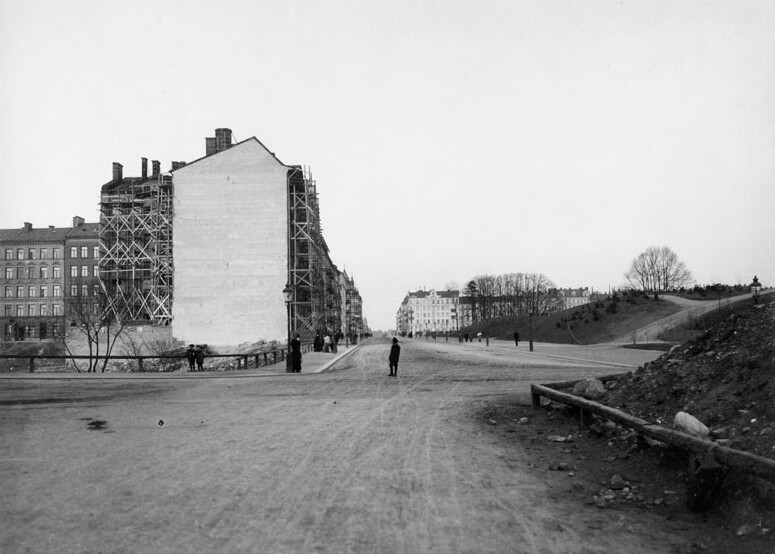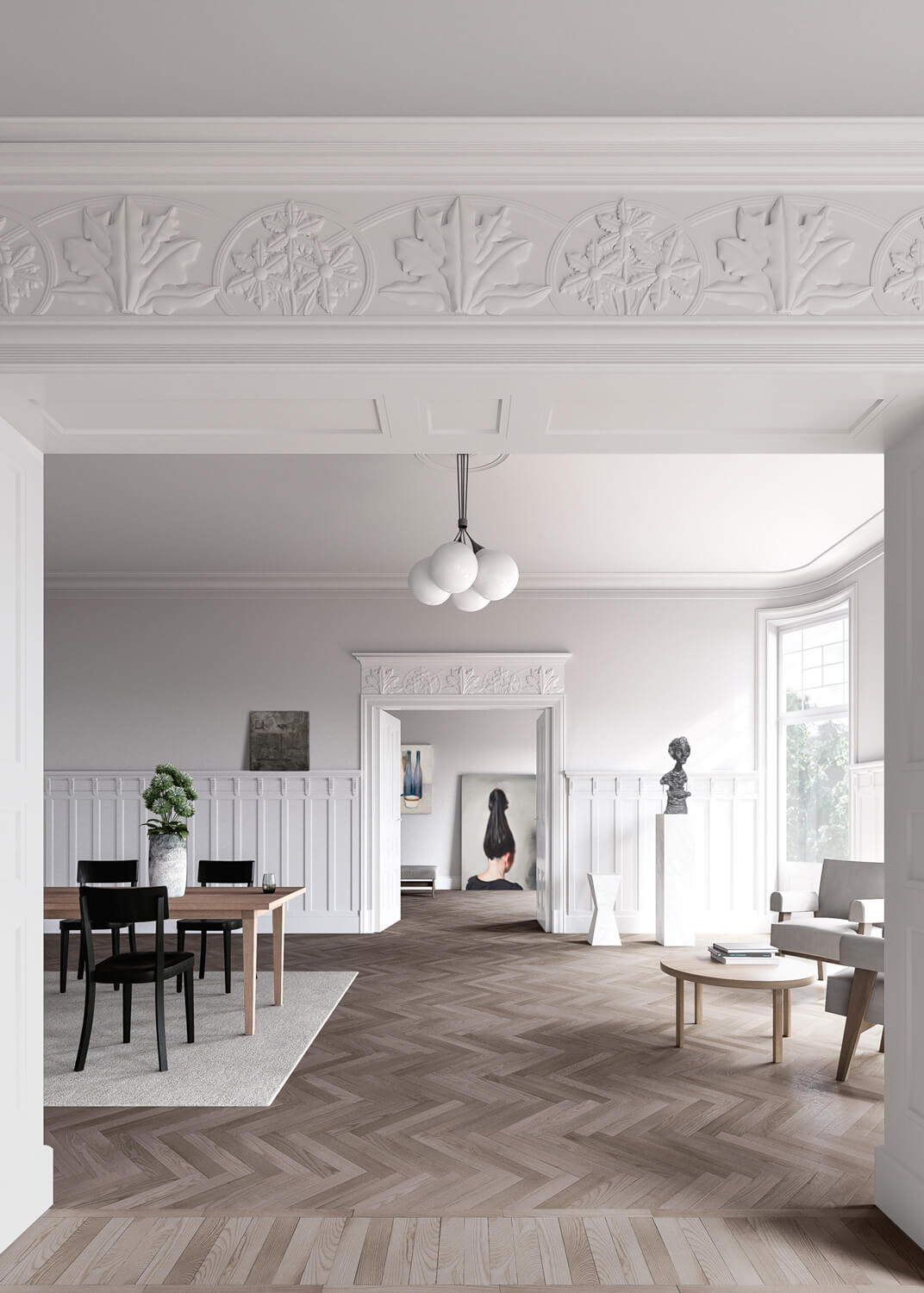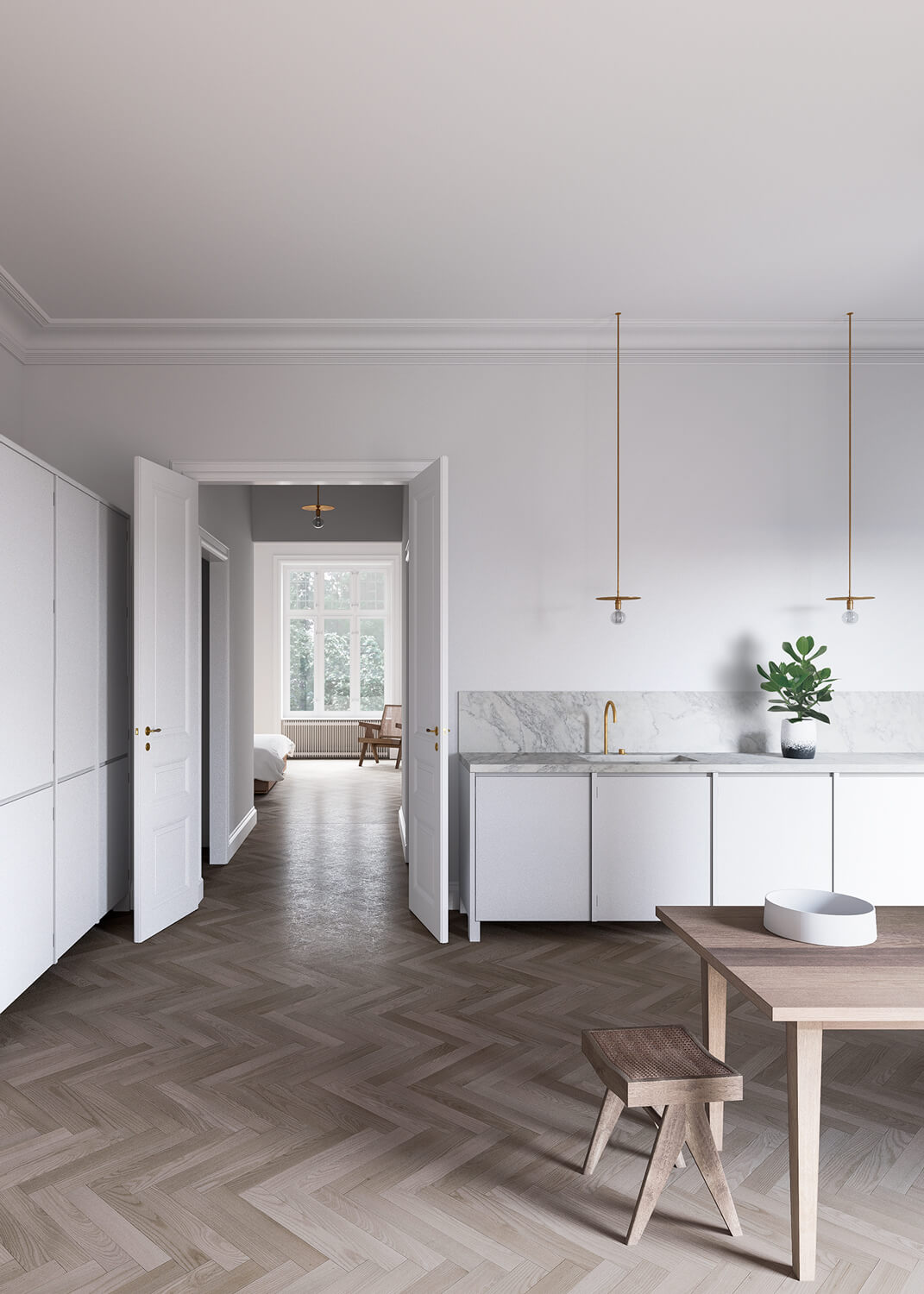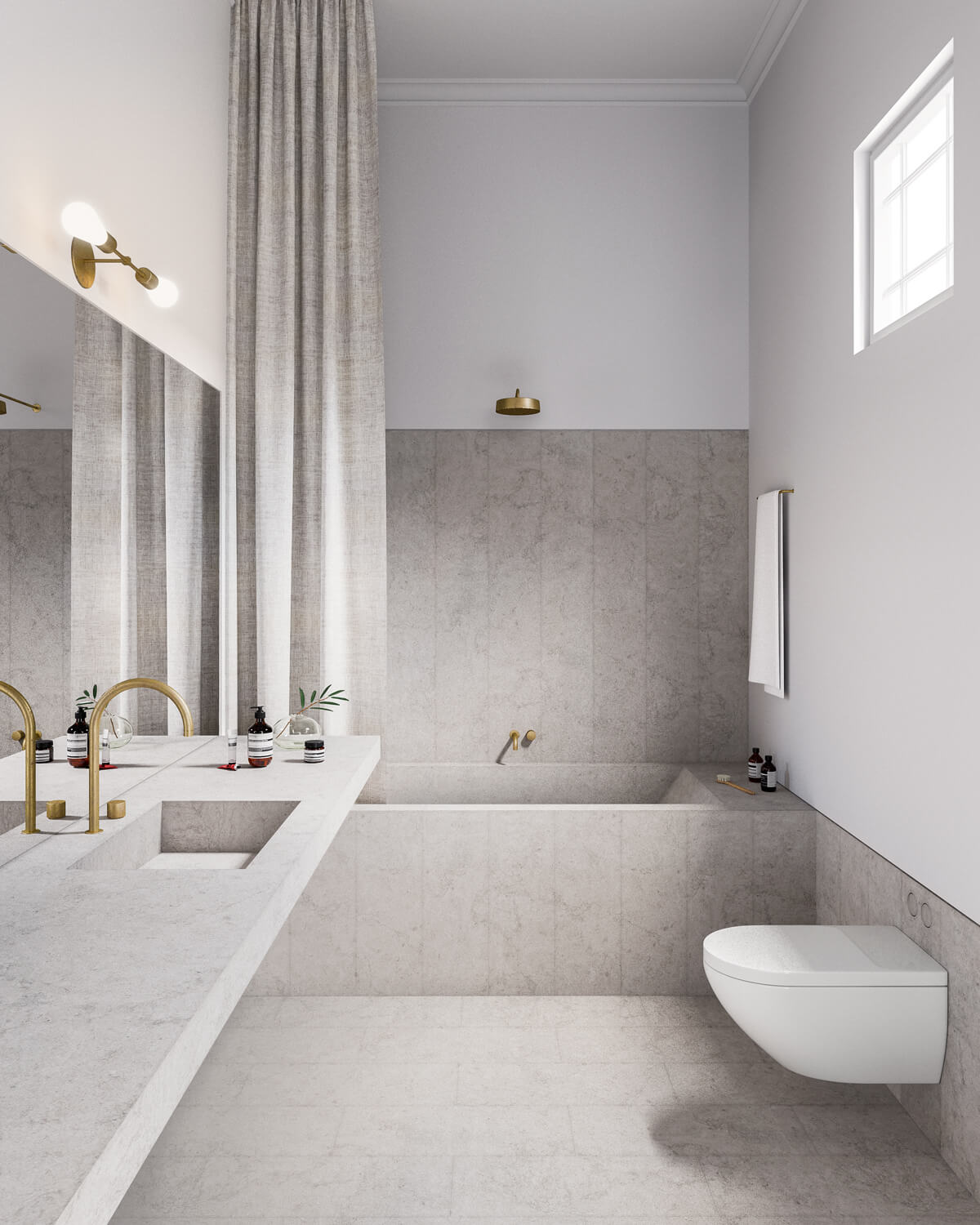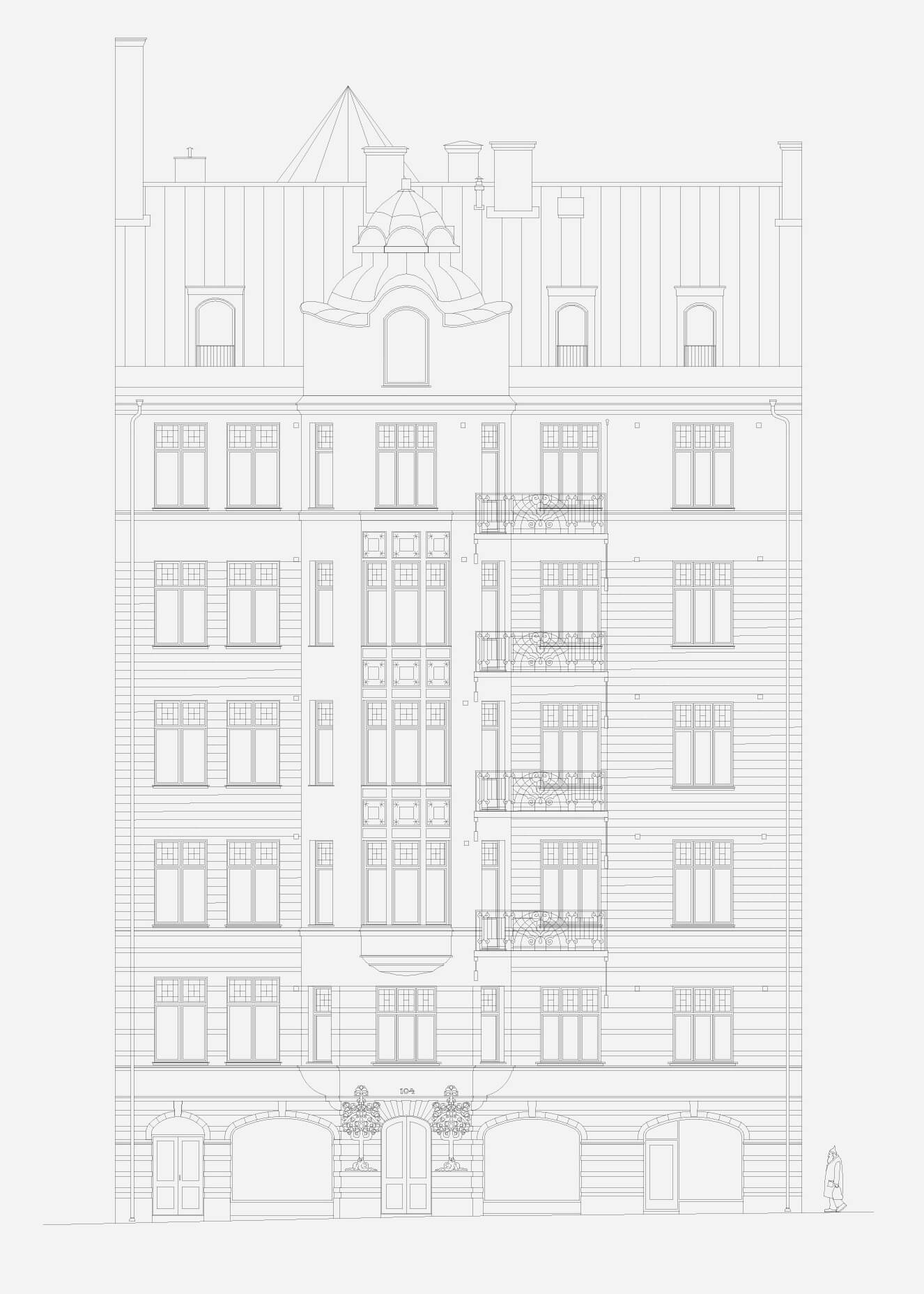Skurusundet Ravine House
Nestled just northwest of the picturesque Skurusundet strait, this small property posed several challenges for potential buyers envisioning a new house. The site is a deep ravine bordered by cliffs to the east and west, with limited road access. While the elevated crags of the property offer stunning views of the Stockholm port inlet, accessing these heights while adhering to planning regulations and feasible building costs seemed a daunting task.
Historically, the area around the property was a summer retreat for people of modest means, characterised by small, simple red cottages available for subsidized summer stays. Due to its proximity to Stockholm, most of these cabins have now been replaced by larger, permanent residences. This particular site, however, formerly held a larger structure; evidence of which can be seen in the terraced landscape walls descending through the ravine, ending in a semi-circular fish pond framed by a solid granite wall.
The new house is a strict three-story structure with a compact plan, that leaves a minimal footprint. By partially embedding the building into the existing steep cliffside, the necessary height for an additional story was achieved while simultaneously reducing visual impact. As such, the building incorporates the existing terraces with minimal further changes. The strict division of the timber into horizontal and vertical elements, opposes the terrain and lends the relation between house and site a strong character.
A central timber stair ties the three floors of the building together and organises the plan. The bottom floor of the building comprises utility spaces. The middle floor is serves as the main entrance floor, holding wardrobes and bedrooms. The fully glazed, open-plan top floor offers striking views of the Stockholm port inlet and is designed for a combined kitchen and living room. Each floor has direct access to different levels of the terraced rock garden outside.
The building uses renewable materials where possible, given the particular characteristics of the site. Where the Saltviga project worked with ennobling off-cuts from floor production, in this project an idea of upgrading raw wood material was tested. Knotty pinewood was turned into knotless pinewood through a select-saw-glue process. The knotty wood was used for invisible interior structural parts, while the carefully selected flawless parts were exposed. As such, the pinewood was turned from an affordable and readily available material into one with more subtle and graceful textural qualities.
Location: Skurusundet, Nacka, Sweden
Status: Completed, 2024
Gross Internal Area: 150 m2
Materials: Pine, Pine CLT, Concrete
Images: (C) Johan Dehlin 2024, (C) KBA 2024
Saltviga House
In our recent projects and in our teaching and research, we have come across Dinesen materials as both the traditional floors and as a scrap, a leftover, an off-cut from the production of made-to-measure floors. Making and thinking with these leftovers from the production gave rise to a notion of making a building of them as a sympathetic way of using and ennobling scrap materials that would otherwise have been used as firewood. Besides being beautiful the off-cuts are low in embodied carbon and could offer an alternative to more commonly used and more carbon intensive materials.
The idea of using the leftovers for a house was developed in a combined strategy of sorting representative pallets of material from the production to classify size, quantity and quality as well as through the building of several 1:1 mock-ups, researching stacking and layering combinations together with technical properties and experiential effects. Differing from traditional split wooden shingles used in Norway, the research into these sawn timber planks resulted in a straight-forward yet complex approach that required traditional material knowledge as well as a considerable process development to make it work in a timely and economical fashion.
The production and assembly of the timber elements for the building drew on the collective knowledge of the involved carpenters, joiners, and suppliers. In the production, each of the 12.000+ individual oak off-cuts from Dinesen’s floor production were pre-cut to size with minimal waste, pre-drilled, and pre-treated with tar at our carpentry before being transported to the site. In the assembly of the facade on site, each individual oak element required precise handling and 20 000+ stainless steel screws for fastening, reinforcing the robust, assembled and layered character of the cladding.
The resulting building negotiates a landscape of rocks, lichen, ferns, conifers and deciduous trees on a bluff, facing the sea of Skagerrak on the south-eastern coast of Norway. Avoiding reshaping the terrain, the building is meticulously adapted to the north-east sloping ground, forming three volumes that are situated on five different levels. Outside, the three volumes create two distinct spaces separated by an openable wind-barrier: a courtyard towards the forest that is protected from the wind and an open deck towards the sea which holds views through an existing pruned “window-band” in the conifers.
Inside, each space has a distinct volume and ceiling height, with the central hallway giving clear views through the whole house and the windows, stretching the full length of the facade towards the sea, bringing unity and coherence to the different levels. Where the exterior oak cladding will turn silvery-grey over time and blend in with the slate and granite landscape, the interior Douglas cladding is kept in a slightly warmer, whitish hue, balanced by the neutral screed floors.
Location: Saltviga, Norway
Status: Completed, 2022
Gross Internal Area: 140 m2
Materials: Dinesen Off-Cuts, Screed
Images: (C) Johan Dehlin, 2022
Engineer: Limträteknik, Falun
Builder: Byggmester Modalen, Høvåg
Located next to Edsviken just north of Stockholm, this project sits at the end of a small secluded residential area close to a suburban centre. With other houses extending predominantly towards the west, the actual property borders on a beautiful sloping oak forest towards the east, making the property semi-private.
The area was originally built up with small white functionalistic “sugar cube” houses, albeit with sloping roofs. As the city grew and people’s tastes changed, the white sugar cubes started to develop in many different styles and directions, turning the area into an experimental field of how to and how not to make additions to the existing architectural fabric.
For the clients of this project, the main drawback of the existing was that the entrance story was not situated on the ground. Although they had a nice big garden, there was no real connection directly to the ground.
The main pièce de resistance was how to successfully unify an additional building volume to the existing functionalistic cube without letting the two clash. How to retain the language of the original while still letting the new speak for itself.
The project in detail studied the old building and identified that the original building envelope had a very stringent and beautiful geometry, but that it had a roof language that formed an enclosed shape which was impossible to extend without destroying the original intention. Therefore the former roof was conceptually removed from the rest of the project.
Playing with the geometry, the new addition makes use of the proportions of the original and elaborates on them. Also, importantly, by making use of the additional internal story height through the addition of an internal staircase to ground level, gives the new addition dimensions out of the ordinary.
Another important aspect was to find a materiality for the new extension that clearly speaks the language of an extension while still interacting with the old volume. Having the rare possibility to use brick in Sweden placed the addition into the realm of stone and render. By using mortar matching the render of the old, the volumes speak in subdued tones of the same mineral language. Further, by using a fairly extreme type of brick with an unusual bond, the addition talks to us in a modern sense without overtly imposing itself of what is left of the existing.
close
A new staircase linking four floors, carefully inserted into a timber house from the 1920s. The staircase is constructed entirely from timber with Douglas fir threads and a closed distemper painted railing. The stepped underside of the stair is a direct result of the construction method where the threads are joined to the railing (or tall stringer) which in turn carries the load towards the durchsicht. Traditionally a total of 13 crafts where involved in the fabrication of a staircase, asserting to the technical and experiential complexity of moving the body vertically through space.
Location: Oslo, Norway
Status: Complete
Materials: Douglas Fir & Lime-Render
Staircase construction: Kitchen & Room
Collaboration: Skapa.no
Images: Paul Paiewonsky
close
The house stands on the island of Vega in the Norwegian archipelago not far from the polar circle. The site is distinctive for its grand and harsh northern landscape with wide panoramas of the Norwegian Sea and the jagged mountains rising from it.
Seemingly growing from the landscape, the house sits on a rock beneath a granite shoulder negotiating the uneven terrain. As not to disturb the dominant view towards the sea, access to the house is given through a narrow natural ravine densely grown with gnarled birch shrubs and laid out with sea-sand from the nearby shore. The surrounding landscape remains untouched and wild.
The large windows of the house face three directions, each with its strong unique characteristic. They are simple and robust in detailing and the optically white glass conveys undisturbed frames of the ocean, the mountain range and the bedrock.
Organised on two levels adapting to the terrain, the plan is compact, providing generous social spaces within a limited floor area. The upper level is comprised of smaller scale bedrooms and family rooms, whereas the lower level is a large gallery-like space structured around a stone hearth.
Completed in linseed oil painted pine with untreated birch skirting, frames and reveals – the interior is kept subtle with a character of being hand-built – promoting tactile qualities and the attractive patina developed over time.
Location: Vega, Norway
Status: Completed
Gross Internal Area: 140 m2
Materials: Larch, Pine, Birch & Sheet Metal
Engineer: Limträteknik
Images © Åke E:son Lindman
Images & Drawings © Kolman Boye Architects
Subtraction / Transformation / Addition
Situated in the centre of the village of Riaz, in between the stone church and the agricultural buildings beyond, the proposal adds a series of carefully arranged spaces to the village centre. With the aim of reinforcing the qualities of the existing situation, the aim of the project is to to re-use as much as possible of the existing and build with locally sourced materials.
Through the transformation of the existing school buildings, the remodelling of the exterior and the addition of a new volume in a considered scale, the new ensemble provides a relaxed yet precise addition to the village.
The strategy for the proposal may be summarised as three key strategies.
1. The subtraction of an old air-raid shelter to create two different exterior levels. The higher, more sheltered level, makes up the playground for the smaller pupils while providing a visual connection to the mountains beyond. The lower, more public level, forms the tie to the village and the entrance to the school proper while also providing space for parking bikes and hanging out.
2. The addition of a new timber building and a wedge formed zwischenraum (in-between-space) that creates a connection between the the different spaces of the ensemble. The space allows the new building volume to adapt and adjust to the constraints of the site while also creating informal spaces that accommodate the entrance, communication and room for improvised activities.
3. The transformation of the two existing volumes through the addition of loggias along the facades. The timber loggias create a common material language and allow for the program to fit in the exiting buildings, reducing the size of the new volume and preventing the need for tearing down.
Addition / Transformation / Re-use Situated in the centre of the village of Riaz between the church and the cultivated fields beyond, the transformed and extended school building a series of spaces to the village centre without destroying the qualities of the existing intimate space. By re-using the volumes of the existing school, removing an old air-raid shelter and by adding a new volume in a similar scale, the new ensemble provides a considered and precise addition to the village.Through a clearing up of the incoherent exterior spaces, the new school clearly defines two different levels connected by exterior staircases. The higher, more sheltered level, makes up the playground for the smaller pupils while providing a visual connection to the mountains beyond. The lower level forms the tie to the village and the entrance to the school proper, while providing space for parking bikes and hanging out. Also the slight rotation of the triptych of buildings plays with the angular space formed by the surrounding streetscape. The proposal aims at creating a tie between the existing disparate buildings by adding two wedge formed spaces in between the new and existing structures and the new addition. These spaces adjust and adapt to the constraints of the site and form the entrances to the school while also creating informal spaces that accommodate communication and improvised activities. The project tries to re-use as much as possible of the existing buildings by adding loggia spaces along the facades. These spaces allow the program to fit into three volumes approximately the same size making the composition well adapted to the scale of the surrounding buildings while letting the church dominate the area. This approach also makes minimal changes to the original structure, reducing the necessity of building more new spaces. Being guided by the idea of maximal re-use, the design is inspired by traditional carpentry techniques, which are adapted to fit with the existing concrete structures. The dominating facade materials are wood and glass.
The house is located near Deggendorf in the foothills of the Eastern Bavarian Central Mountains. The municipality has historically held an important position in Bavaria and is today a centre for the timber trade of the Bavarian forest and the seat of several mills, stonemasonries, potteries and other industrial establishments.
Rindberg is spatially characterised by a unified building mass adapting to the uneven terrain by either following the topography or crossing it perpendicularly. A small chapel and a fire pond define the centre of the community, with buildings branching out along a main street running the length of the mountain ridge and a secondary, more intimate street, following the curvature of the brow.
The property, originally pasture lands, occupies approximately 1,5 acres of meadowland on the Northern edge of the village. The pocket of land constitutes a natural growth for the village, up the steep mountain that has given it’s name to the community.
Situated 520 meters above sea level and rising an additional 25 meters, the site holds broad views of the Alpine Foreland with the snow covered peaks acting as a backdrop to the South. To the West, the Danube river flows through an expansive rolling agricultural landscape, underlined by the village roofscape and ending behind the rocky mixed forest of the Bavarian Forest National Park to the East.
To maintain the intimate atmosphere of the village, the new addition is situated on the southern part of the property between ancient solid-timber buildings set on stone foundations, weathered larch-clad agricultural buildings and mature broad-leaved trees.
A wall to the South connects to an oak fence that runs around the entire perimeter of the property, keeping the grazing sheep from wandering away while not obstructing the visual connection. The surrounding meadow is kept by the animals and apart from an assortment of fruit trees further up on the site, the land remains unfarmed and lush.
The brief for the house was developed from the clients ideas about the spatial organisation, through volume studies in a large model of the site and neighbouring village. On the basis of this study, the clients formulated a short and precise list of wishes:
1. The house should be a building in three stories, to hold the view of the Alps in the distance.
2. The house should be a timber building, making equal use of modern cross laminated timber technology as well as local architectural and craftsmanship traditions.
3. Each floor of the house should have four large openable windows, facing each of the cardinal directions, providing a distinct identity to each room.
Location: Lower Bavaria, Germany
Status: Planning
Gross Internal Area: 210 + 60 m2
Materials: Larch, Pine CLT, Concrete
Engineer: Eiler Holzbau
HC Hansen Image: Seier + Seier
Images: Kolman Boye Architects
As a part of the Design X Change sustainability fair, teachers and students from the Royal Academy for Architecture, programme for Cultural Heritage, Transformation and Conservation (transformation) have designed and built a temporary pavillon for the Danish Design Museum.
The pavilion is set in the beautiful enclosed garden of the former Frederiks Hospital, designed by Nicolai Eigtved and Laurids de Thurah, subsequently transformed by Ivar Bentsen, Thorkild Henningsen and Kaare Klint.
The pavilion is organised in a U-shape, building on the garden’s layering of walls and trees. It is constructed from locally sourced douglas timber, reclaimed brick and reclaimed scaffolding tarp. It is joined by 196 handmade timber-joints, inspired by our recent study trip to a Minka builder in Japan. The flexible joints are traditionally used in earthquake-prone areas and allow (in this case) for the structure to be easily disassembled into reusable components.
Teachers / Design
Charlie Steenberg, Morten Gehl, Nicolai Bo Andersen & Victor Boye Julebäk
Students / Joinery
Anders Aalekjær Grønbech, Anine Kildal Haneseth, Arvid Carlström, Christian Minor Nørbjerg, Esben Slotmann Jensen, Frederik Lauge Jørgensen, Frida Andersen Lødrup, Jonathan Pihl Petersen, Jorunn Reginsdottir, Karl Smith Meyer, Karoline Juhl Jessen, Laura Lindblad Okkels, Lars Sigersted, Lovisa Bondeson, Mathias Rasmus Bayer, Michael Brandrup, Mikkel Eske Kjærholm, Oscar Forsman, Rikke Piil, Salem Samih Charabi, Sanna Mattsson, Signe Bay Bøgh Larsen, Sigrid Cederberg, Simon Lindberg, Sindre Aarhus Narvestad & Tanya Gudmestad
–
I Designmuseum Danmarks have ’Grønnegården’ har studerende og lærere ved kandidatprogrammet Kulturarv, Transformation og Restaurering KTR på Kunstakademiets Arkitektskole KADK bygget en pavillon som led i Design X Change 2018.
Design X Change er Københavns nye bæredygtighedsmarked, som blev afholdt i weekenden d. 26.-27. maj 2018 i forbindelse med Danish Design Festival 2018.
Festivallen havde igen i år fokus på bæredygtighed og materialegenanvendelse. Målet er at arbejde sammen om at nærme sig FN’s 17 verdensmål som bl.a. handler om at mindske ressourcespild og sikre en bæredygtig udvikling.
Museets smukke gamle bygninger der dannede ramme om pavillonen blev bygget fra 1752 til 1757 af arkitekterne Nicolai Eigtved og Laurids de Thurah. Bygningerne der oprindeligt husede Det kongelige Frederiks Hospital blev dimensioneret med sygesengen som grundmodul. Hospitalet blev i 1926 omdannet til museum af Ivar Bentsen og Thorkild Henningsen med møbler af Kaare Klint og lamper af Poul Henningsen. I gården ligger en smuk have der udgør en lille grøn oase i byen.
Pavillonen blev bygget som en U-formet konstruktion af træ sammenføjet med træsamlinger inspireret af japansk arkitektur. Samlingerne er karakteriseret ved at være fleksible så de kan modstå jordskælv(!) og ved at de let kan skilles ad så konstruktionen kan genbruges et andet sted. Pavillonen stod på punktfundamenter af genbrugssten og havde en tagbeklædning af genbrugt stilladspresenning. Konstruktionens klare tektoniske leddeling og karakterfulde materialekarakter gav pavillonen en stærk arkitektonisk karakter som ramme for Design X Change 2018.
close
Not very far from Stockholm, close to the summer town of Norrtälje, situated among innumerable traditional Swedish summer cottages and pine trees, lay three small deep brown houses of different sizes. Built on a common deck acting as a massive plinth, rising out of the moss clad grey granite, these three small buildings placed close together make up a summer hideout, the deck flowing in-between them acting as an inhabitable fourth room.
The façade is made from deep-brown phenol coated plywood, normally used for casting concrete. Is is affixed with special screws used for fastening metal roofs, giving the house a certain prominent metallic harshness. The doors are treated in the same way, reusing the dark-brown metal sheeting from the roof, albeit orienting the sheets vertically.
In contrast to the hard exterior, the interior is light, being made almost completely out of white-waxed birch plywood. The velvet texture of the veneer attracts the light let in through the cut-outs in the walls. Utmost care has been taken to the interior, making everything from one single material and aligning all joints giving the impression of a piece of furniture.
Location: Norrtälje, Sweden
Status: Completed
Gross Internal Area: 60 sqm
Materials: Plywood, Sheet metal & Larch
Collaboration: Tove Fogelström
Images: Kolman Boye Architects
Commissioned by Wallpaper* for the Handmade exhibition at Salone del Mobile in Milan, the installation was developed in collaboration with cabinet makers Benchmark and backed by American Hardwood Export Council Europe as a pick and mix articulating the technical and aesthetic qualities of american black cherry.
The installation combines an interest in traditional woodworking techniques and the photographic documentation of silent buildings by Bernd & Hilla Becher and Ole Meyer, creating a functional sculpture within the walls of a gallery.
Meat – A spatial strategy exploring the notion of aedicula, forms the body of an enclosed vertically pronounced space within space, that establishes a lively gathering point in and around the heart of the gallery.
Bone – The structure of the installation is informed by an intention to forgo the use of glue, metal brackets and screws in exchange for wooden joints. It consists of 12 elements set at an angle of 30 degrees to each other creating a closed, almost cylindrical, polygon comprised of 4620 parts.
Each leg of each element consists of doubled framing studs, clasping inclined rails that in turn carry the shelves. The shelves holding the serving trays are joined by mortise and tenon joints and act as barrel hoops allowing the large amount of loose-fit components to act as one structural whole.
Skin – The skin of the installation consists of 528 stacked wooden take-away trays tooled with a purpose made, ball shaped drill to create a soft concavity for serving. Conceived as a transformative process, the installation will by each serving slowly be reduced from a rotunda-like space with casette-walls to an open carcass.
Location: Milan, Italy
Status: Complete
Gross Internal Area: 12,5 sqm
Materials: American Black Cherry
Manufacturers: Benchmark Furniture
In co-operation with: AHEC Europe
Engineer: Arup United Kingdom
Images: Petr Krejci
Located in a typical villa suburb of Stockholm, this project is a full-blown makeover of a dark-brown brick and wood building from the 1970s.
The design intent is diametrically opposed to what was there before.
Materiality chaos and multiplicity has been replaced by a reduced and refined material palette of render, limestone and sheet metal. Irregular features are now strictly regular throughout the facades.
Albeit there is nothing left today reminding of the old, the new basic form was inherited and transformed into something with a radically rethought design language inspired by classical references.
closeSituated within the lush private home movement gardens of Enskede in Stockholm, the project proposes an alternative way of living in the periphery of a rapidly expanding city. The organisational approach aims to meet a society in flux by introducing a more compact and diversified living pattern that debates the tendency towards low density suburban land development.
The current lack of housing in many of Sweden’s urban municipalities is similar to the sociopolitical situation that gave rise to the private home movement at the turn of the century. As a result of the overcrowded living conditions, political measures where taken to claim large areas of land for the construction of simple workers’ housing. The dwellings where based on standardised construction documents and simple tectonics, allowing a moderately experienced builder to erect a small house with a generous garden at a a low cost.
Being buildings of valuable cultural heritage our proposal aims to curb the tendency of grafting onto the unadorned, well proportioned self build houses by means of a freestanding, complimenting 25 sqm volume granted under the Attefall-house Law of 2014.
The new additions are situated along a proposed narrow mews, lined by tall hedges and mature fruit trees, facing the adjacent neighbour plot. The placement creates a series of thresholds with varying spatial characters mediating between room, house and gardens.
A light wooden frame clad in tinted fibre-cement, resting on prefabricated concrete sleepers with a sheet metal roof is proposed for the construction. The interior framework is lined with thick felt and spatially organised around a large fixed window framing a view of the internal mews.
This direct form of construction and material palette is informed by a notion of heightening the aesthetic qualities of commonplace materials and allowing a direct visual understanding of the tectonics.
With these additions to Gamla Enskede we seek to articulate the unique qualities that are derived from the condition of living in a garden city where one can easily sense the feeling of community. Small robust buildings that attend to the functional requirements of a home while providing a meaningful connection to the culture, landscape and architectural tradition.
Swedish Version
Projektet tar sin utgångspunkt i förortens villaträdgårdar och arbetar med en alternativ boendeform som kan möta ett samhälle i förändring genom att introducera andra livs- och boendekvaliteter och därigenom bidra till ett mer diversifierat samhälle. Önskemålet om allt mer yta per person har ökat de senaste åren samtidigt som det byggs allt färre bostäder i städerna. Med allt större krav på standard, lokalisering och avskildhet går utvecklingen mot ett glesare boendemönster snarare än den förtätning som städerna är i behov av.
I takt med att behoven för bekvämlighet och utrymme växer, ökar behovet av större bostäder. Detta resulterar ofta i att de boende transformerar sina hus för att möta de nya behoven. Sveriges villaförorter har under många år genomgått en arkitektonisk förvandling genom tillbyggnader av balkonger, burspråk, takkupor samt verandor. Komplementhusets potential ligger i möjligheten att kunna fungera som en avknoppning till ett existerande hus och därigenom ta över eller komplettera en del av dess funktioner.
Vårt komplementhus placerar sig i en typisk förstadstypologi nära stenstadsgränsen och strävar efter att förtäta en existerande bostadsstruktur. Många av landets kommuner har idag en stor bostadsbrist som
kan liknas vid bostadsbehovet som gav upphov till 1920-talets egnahemsrörelse. På grund av trångboddheten efter sekelskiftet genomförde städerna bostadspolitiska åtgärder som resulterade i att stora landområden uppläts för byggnation av enkla och standardiserade arbetarbostäder. Bostäderna skulle uppfylla två kriterier: vara lätta att uppföra och samtidigt vara billiga. Byggnadsdelarna var till stora delar elementbyggda och följde enkla ritningar, vilket gav en oerfaren byggare möjlighet att uppföra sitt eget hus. Många av dessa egnahemsområden är utpekas idag som värdefulla kulturmiljöer vilket ställer större krav på framtida additioner och transformationer.
Med utgångspunkt i tanken om trädgårdsstaden har vi försökt att skapa en kontext där komplementhuset kan fungera som en katalysator för ett levande och grönt samhälle. Skapandet av ett gemensamt rum kan bidra till en känsla av samhörighet som i sin tur kan generera en rikare boendemiljö. Komplementhuset är utformat för att kunna tillgodose olika typer av bostadsbehov, såsom generationsboende, studentboende eller äldreboende. I relation till den existerande huvudbyggnaden skulle detta kunna ses som en modern tolkning av ett kollektivt boende. Att möta nya bostadsbehov med ett komplementhus ger plats för den ursprungliga bebyggelsen att bevara sitt uttryck och sin komposition. En existerande kontext blir istället någonting man förhåller sig till och samtidigt kan förädla.
Förslaget förhåller sig till en klassisk tomtindelning men introducerar en inre passage mellan fastigheterna, där komplementhuset kan nås via en separat stig. Det skapas därigenom ett gemensamt mellanrum, en ”mews”, på baksidan av det existerande huvudhuset. Komplementhuset kan därefter orienteras för att skapa mer eller mindre insyn för de boende, beroende på behovet av avskildhet.
Vår intention har varit att skapa ett modulbaserat hus, där husets delar lätt kan sammanfogas på plats. Materialitet, fasadindelning och konstruktion refererar till det enkla egnahemshuset, en sammansatt konstruktion där husets delar enkelt kan bytas vid behov. Fasadskivorna består av infärgad fibercement efter önskad kulör som med tidenpatinerar vackert. Skivorna fästs på horisontella läkt för att skapa en överlappande, storskalig shingle-struktur. De översta väggskivorna är ornamenterade med små hål, vilket filtrerar ljusinsläppet till det inre rummet. Pannplåten lägger sig som en nätt plisserad metallskiva ovanpå en tunn filigrankonstruktion som bär det uthängande taket.
Huset frigör sig från marken genom ett stolpfundament i betong varpå ett bottenbjälklag placeras. Husets bärande ramverk består av en enkel regelkonstruktion med mellanliggande isolering, vilket ger möjlighet för en varierad indelning av det öppna rummet efter behov. Generösa gemensamma ytor kompletteras med kompakta privata.
Den bärande konstruktionen är synlig från insidan och ramar sålunda in väggarnas filtklädda paneler. Bad och sovrum placerar sig i rummets båda ändar. Sovalkoven har visuell kontakt med det stora rummet genom ett fönster som skapar en inramning av vyn genom huset. Köket placerar sig som en fristående möbel i rummet likt en gammal sättugn och fungerar som husets medelpunkt. Husets fönster består av ett stort fast glas, monterat direkt på en regelram som i sin tur monteras som en förlängning av själva konstruktionen.
Location: Enskede, Sweden
Status: Completed
Gross Internal Area: 25 m2
Materials: Fiberconcrete, Pine, Felt & Sheet Metal
Client: Bokeförlaget Max Ström
Images: Kolman Boye Architects
Sorens is characterised by a coherent connection to the surrounding landscape with detached buildings strung along the Route Principale, running the full length of the village. The site for the new school in Sorens is distinctive for its placement on the edge between farmland and the more articulated space of the street.
To the East and South, the site holds clear views over the expanse of fields – dotted by agricultural buildings – towards Lac de la Gruyère at the foothills of the Alps. The North and West are defined by the village, with the higher lying fields and the forest of Le Gibloux as a backdrop.
Sitting in the slope towards the centre of the site and with its orientation being in accordance with that of the village, the placement ensures an expedient use of the grounds and an open view of the landscape for the neighbours residing towards West and Northwest.
The proposed volume takes its place within the simple and direct character of the buildings of the agricultural landscape, whereas the relief and rhythm in the facade seeks to compliment the more formal character of a civic building.
The building is organised on four levels with a generous ‘hall’ that holds varying views of the landscape at the middle.
Around the the central space each classroom is placed on a corner with windows in two directions ensuring sufficient natural daylight.
Large glazed openings to the central space allow glimpses across the floors from room to class to outside, such that the interior feels very open and full of the sum of everyone’s activity, underlining the feeling of community while allowing room for concentration.
The design is directed by a strategy of using linings and claddings that serve both an aesthetic and a functional purpose. An internal lining protects the walls where the wear is toughest and accommodates storage and seating. The external cladding serves to protect the joints in the prefabricated timber elements and the depth it gives to the facade shelters technical components such as sun shading and windows.
This direct form of construction and reduced set of materials reinforce the whole and create sufficient flexibility to accommodate the variations in structural spans and internal room dimensions required by the programme.
With our project we aspire to introduce a new and enriching addition to Sorens. A robust building that minutely attends to the functional requirements of a school while providing a meaningful connection to the culture, landscape and to the architectural tradition.
Location: Sorens, Switzerland
Status: Competition, Awarded Proposal
Gross Internal Area: 1900 m2
Materials: Concrete, Larch, Lime Plaster & Sheet Metal
Consultant: Architecte Linus Godet
Images:Kolman Boye Architects
“What would be the great temple of the Parthenon,
without the Acropolis to act as its plinth …”
The old school complex from the fifties in the area of Montbenon in Lausanne needed a sizeable addition to house new generations of pupils. The steeply sloping site was excavated to accommodate part of the extensive programme, stacking its functions along the street in different levels, thus leaving open the views from the old school towards Lac Leman.
Trying to reinterpret the language of the typical stone, concrete and render facades of the era, the new school assembles stone and concrete elements in a lively but very strict facade. On the roof a lush play garden was conceived with a beautiful view over the lakescape.
Location: Lausanne, Switzerland
Status: Competition
Gross Internal Area: 5050 m2
Materials: Concrete, Limestone & Glass
Consultant: Architecte Linus Godet
Images: Kolman Boye Architects
On a steeply rising property within a tall beech forest, overlooking the flat agricultural lands of southern Sweden, the atelier forms a group with an old wooden house with a long history of alterations and a mature sheltered garden adorned by ceramic and brass sculptures.
The clients, a family of artists, wanted a simple retreat from the bustling activities of the main house which could adapt to the changing needs of additional working and living spaces.
Sitting high on a ridge to the North of the main house, the atelier is accessed by a granite staircase carefully adapted and carved into the terrain. The secluded position allows for large wall size openings, framing the varying scenery of treetops and endless countryside.
Clad in copper and wide horizontal larch planks the material language of the house is in part analogous to the artistic work of the family and in part to the main building.
The atelier is comprised of two interlocking volumes sitting on a slight angle to each other. Consisting of a single large room with a bathroom and kitchen concealed in a deep back wall, the subtle twist gives an unexpected spatial complexity to the whitewashed interior.
A cantilevered window acts as a small bed, allowing the granddaughter to wake up amongst the trees.
In time, as the vegetation grows closer, the atelier will become a part of the dense garden, revealing itself only from certain views.
closeTransformation of a residential building
The apartment building Liljan 3, situated on Odengatan in central Stockholm, is an unique example of the Jugendstil in Stockholm at the turn of the last century. The competition brief seeks to reinstate the building as a residential complex, where flats are managed by individual owners collectively caring for the building maintenance.
Originally drawn in 1903 by then renowned Architect Martin Borgstedt, the building is filled with intricate floral details handcrafted from wood and plaster. In the entrance hall one is met by a dense botanical language represented in tiles, doorways, cladding and skirting details. The hallway full of mirrors, leading up to the centrally placed stairwell and original elevator, similarly gives a rich impression of the floral jugend ornaments. Also the apartments present plentiful elements from the epoque, all of which were integrated into the reconstruction proposal.
The building is historically listed and “is of significant cultural heritage from an historical, environmental, and artistic point of view.”
The proposed reconstruction scheme tries subtlety to enhance the building’s original traits to reinstate its former atmosphere and grandeur. The relatively minor alterations seek to carefully maintain historical details, whilst integrating elegant solutions for bathrooms and kitchen and sometimes opening up the plan to allow for a modern way of living. By also extending the partly unused attic space, the intricate roofscape allows for some modern architectural language which overlooks the quarter’s many playful courtyards.
closeSummerhouse Stora Elgön
A common problem when designing buildings in the Stockholm archipelago is to handle the slope towards the sea while optimizing the amount of facade towards the view. Often the space below the actual house is just concealed. Or the building adapts to the ground using decks on different levels. In this particular project the solution was to place the whole building on stilts, leaving the cliff surfaces exposed below.
Simple rectangular wooden columns carry deck, structure and roof above the granite bedrock. Some parts are fully open with only structure above, some are fully covered and inside. The building floats above the rock without touching or destroying.
Location: Stora Elgön, Sweden
Status: Sketch Phase
Images, Models: Kolman Boye Architects
Norwegian Forest Finn Museum
The Forest Finns immigrated from Finland into the area between Sweden and Norway in the 16th century. They were looking for sizeable swaths of uninhabited forest where they could practice slash-and-burn agriculture. By the end of the 16th century most of the immigration had stopped. During the next three centuries the Forest Finns were assimilated into the Norwegian society but kept there special cultural traits.
The project constitutes an attempt of bringing together both the material and non-material heritage of the Norwegian Forest Finns in a contemporary museum. The new museum consists of four straight forward timber buildings that are organised around a courtyard on an elevated stone plinth that can cope with the swelling of the neighbouring river. The building materials are sourced locally and joined together in a simple and robust structure which is equally informed by traditional timber construction as by modern technology.
The interior, cavelike space, is built on three experiential qualities that draw on the archeological remains of the Forest Finn building culture: the deep blackish-brown char pigmenting of the timber which is present in the interiors of traditional houses as a consequence of wood burning, the balanced raking light that draws the texture of the materials and gives an impression of being filtered through smoke, and the expressive load bearing structure that acts as a focal point, gesturing towards the sky alongside the smokehole (tag-lyre).
The resulting building is a spatial tension between tranquility and movement, between the airiness of the clearing in the woods in which the building is situated and the deep interior of the building.
Location: Svullrya, Norway
Status: Competition
Materials: Charred wood, Smoke & Light, Concrete
Images: Kolman Boye Architects








































































